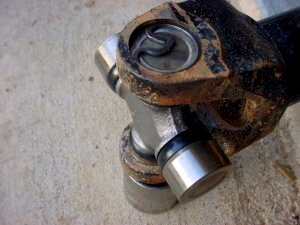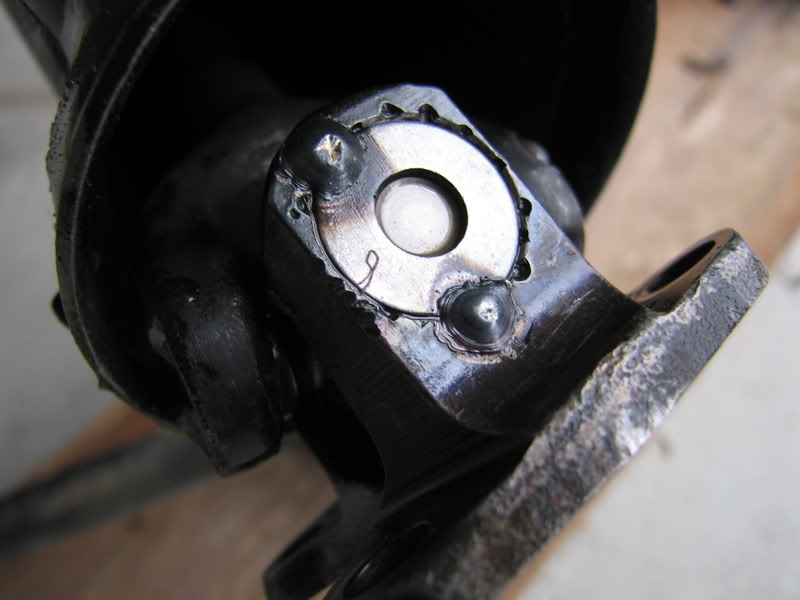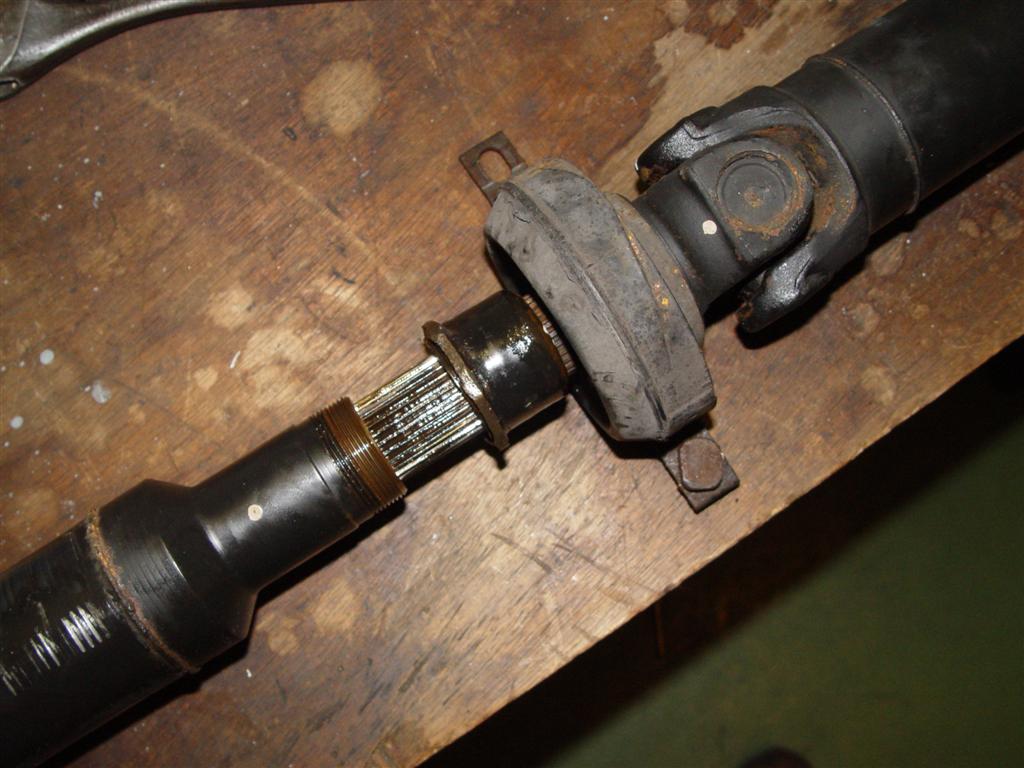BMW (including E30’s) and some Mercedes drive-shafts particularly of the 80’s-90’s vintage have what are called non-serviceable staked in u-joints. Over-time the grease inside the u-joints drys out, get pasty or otherwise stops performing its job; this causes the u-joint needle bearings to bind. Binding u-joints will cause vibrations to be felt at a specific speed range, RPM range, or cause clunking. If minor enough the vibration will not be felt until the CSB (center support bearing) has had enough and rips. A new CSB can be installed and likely take the vibration away, however it will be short lived and you will be pulling the shaft out once again within months time.
This is what a torn CSB looks like, however note that if the binding is moderate then you will feel the vibrations before this bearing fails:
To know if your U-joints are bad you will need to pull the driveshaft out and move each of the 2 U-joint in all 4 directions, there should be no stiffness and it should not feel notchy.
Here is where the fun starts:
There are two reasons u-joints are not serviceable on our driveshafts. First is because the factory U-joints do not have grease zerks, there is no way to add fresh grease without replacing the u-joint. The second reason these are not serviceable is because from the factory the u-joints are “staked in” or welded/tacked in. On serviceable drive shafts the u joints are held in by circlips, which can easily be removed to allow for u-joint replacement.
Serviceable (what we don’t have):

The problem is not removing the old joints, the tacks can easily be ground away, the problem is putting new u-joints in. You might be saying, why not tack the new ones in? The reason is alignment; serviceable u-joints have machined circlip grooves that ensure proper alignment of the ujoint on all sides, something our driveshafts do not have. At the factory the driveshafts were made by a machine which had the ability to measure the depth before tacking/staking.
This makes the u-joints a non-DIY job unless you have precise measurement tools capable of 5 thousands of an inch (0.005″). You will also quickly find that many local driveshops will not touch these driveshafts because they also do not have these precise tools. They will not perform the job because of the likelihood that you will come back complaining of a unbalanced shaft. The reality is that most driveshaft shops do have precision tools capable of rebuilding your shaft without balance issues 8 out of 10 times, but they wont take the risk because although their tools are precise they are not precise enough to get a 10/10 result.
There are multiple options available:
1. If you are lucky enough to have a newer BMW or Mercedes shaft with milled inner ears (the part that holds the u-joint) then you can use new style u-joints that use inner clips for alignment. These inner clips will align the u-joint perfectly and then they can be tacked in with confidence. Note an E30 does not have a machined inner surface, so this is a non-option.
2. Find a driveshaft shop that is capable of this job, if you live in a major city most lesser grade drive shaft shops will tell you where to go to get staked in u-joints serviced. It may also be beneficial to ask local BMW shops for recommendations.
What many shops will do is tack the head of the joints or weld in a washer as a pseudo-permanent circlip:
If all else fails, look into semi truck driveshaft shops, most big rigs use staked in u-joints and this is something they are used to working on. However be aware that although their price and enthusiasm may look appealing, there are a couple problems.
First, the smaller the drive shaft the more precisely you must position the u-joint, they are used to working with big u-joints and lesser precision; make sure they have the proper measurement tools to do the job correctly.
Secondly the issues of balancing, and this isn’t exclusively a big rig drive-shaft problem. Any shop that is not used to working on these shafts will not have the proper chuck attachment for their balancing machine and will not be able to balance your shaft or will charge you to mill a custom chuck at your expense.
Balancing is not completely necessary if you can ensure that the new u-joints where installed with appropriate precision, new u-joints by them selves do not through the drive-shaft out of balance. Serviceable driveshafts for instance do not need to be balanced because the circlips ensure alignment.
Consider balancing a requirement if the shop is willing to tack in new u-joints but are not confident in their precision ability. Balancing will take away any errors made.
3. Order online from a reputable source.
Driveline service of Portland has been known to be able to do this job properly in the USA and Cardanic Driveline & machine shop in Canada. As have been many other suppliers. Some quality time spend on enthusiast forums will render many options.
E30 Specific:
Many driveshafts shops may have an issue finding the proper sized u-joints for an E30; be rest assured that OEM and OE ujoints are still available. Most shops that do these rebuilds often will know of local suppliers so there shouldn’t be a reason to order the joints separately. Many will even know of u-joints that are the correct size and have zerk’s for periodic greasing. However for those wanting to supply their own joints or who are in circumstances where they need u-joints:
BMW part number: 26117518304 (supersedes 26111105398), Meyle 3142611104.
U-joint with zerk (for illustration only):

Lastly, when reassembly your drive shaft do not forget to align both pieces as they were balanced from the factory (or as otherwise marked by the driveshaft shop), it is advisable to also mark the driveshaft before separation. The factory alignment marks for an E30 are two white dots applied at the factory. If you do not do this last step you will have an out of balance driveshaft.










Recent Comments